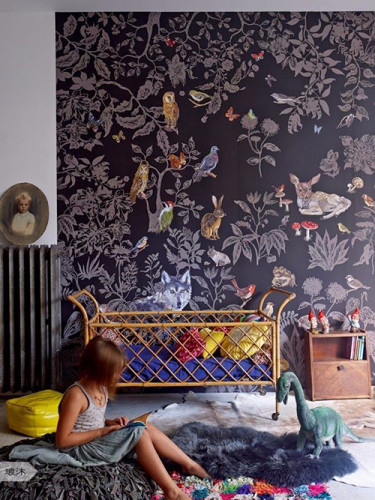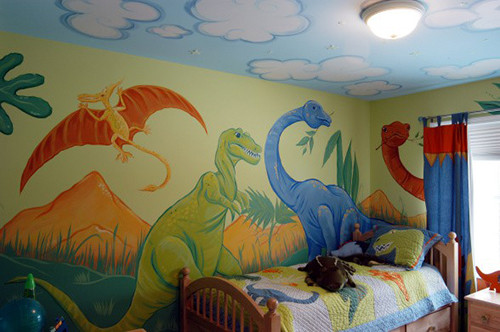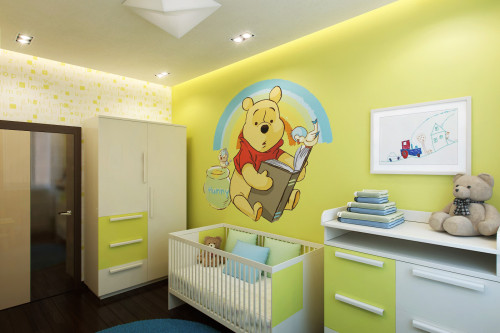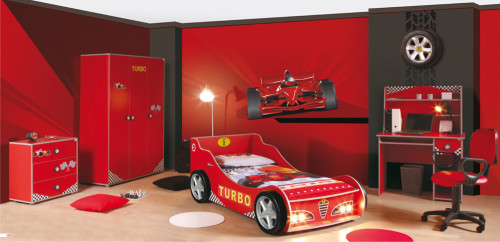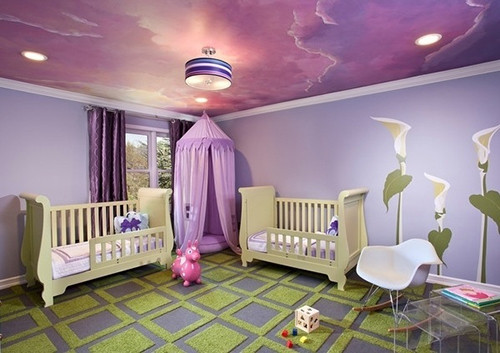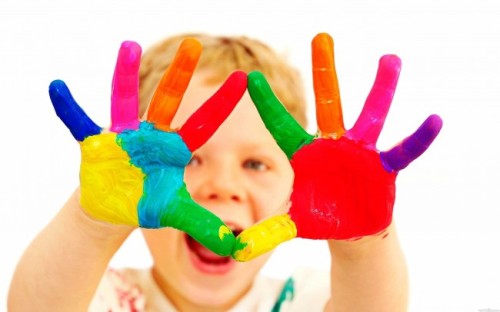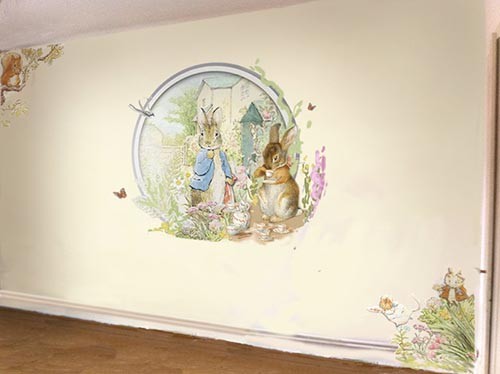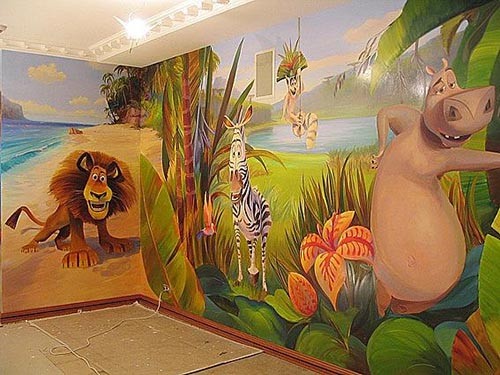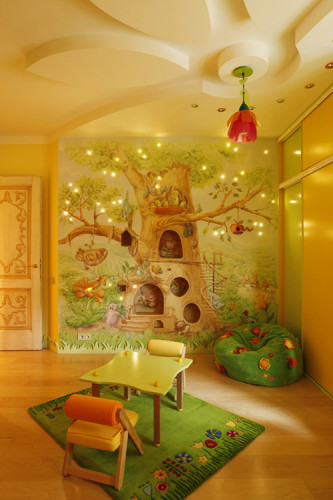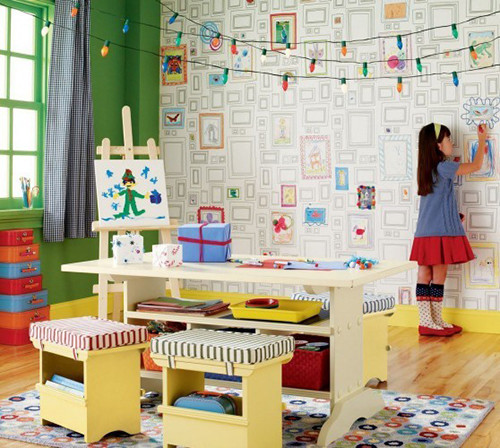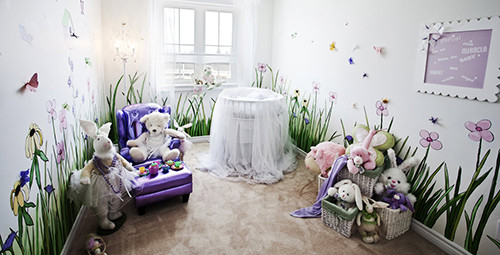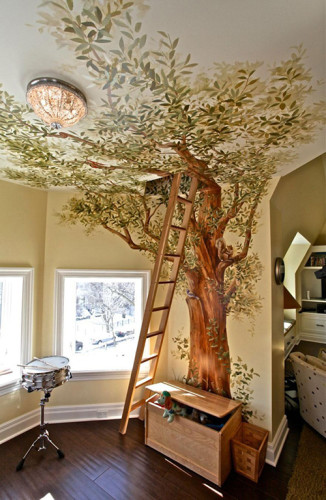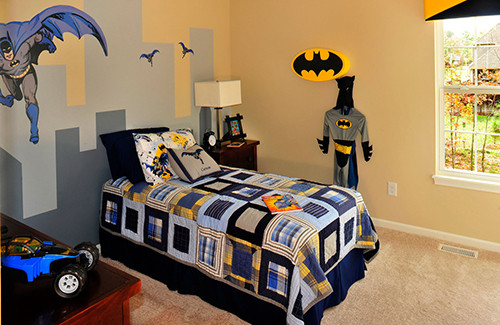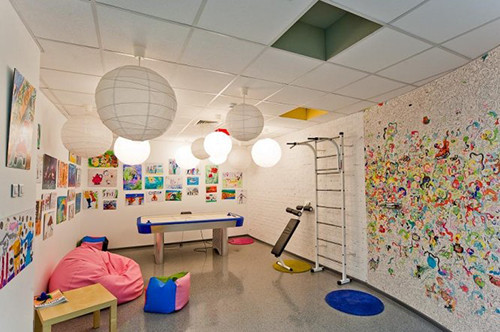Each parent dreams that his child grows up with a creative, comprehensively developed and interesting person. The foundation of these qualities should be laid from the first days of the baby’s life, when he already begins to actively absorb all the information surrounding him. In the first months, this occurs only at the visual, auditory and tactile level. The color situation is very important not only for babies, but also for people of any ages. It colossally affects the worldview and psyche, and therefore the wall painting in the children's room should be carried out more than consciously. In this article, we will tell you everything that you need to know for the correct painting of the nursery.
Content
How to transform the nursery
The modern market for finishing materials offers a huge selection of colors for rooms, however, far from every paints are suitable for an artistic painting of the children's room. We will dwell on this a little lower, but for now let's think about why the children's painting is so popular?
First of all, this technique makes it possible to radically transform the room and give it an individual style. In your will to create any composition corresponding to the age, floor and the preferences of the child. If you choose the right paint, it will retain its original appearance for many years, so you can not remember the repair until the child grows up.
Another advantage of wall painting above other methods of decoration is that you can create a comfortable space specifically for your child. The finished “template products” can not always catch and emphasize the character characteristics of the baby, while in this regard it is much more convenient.
However, in addition to the classical painting of walls, there are other ways to transform the children's room or use mixed options:
- Wallpaper-painting-wallpaper with the applied contours of images. The child will be able to independently color the room in his favorite colors. Such wallpapers appeared on the market relatively recently, but immediately gained popularity. Moreover, they have already come up with painting wallpaper not only for children, but also for adults with more complex and detailed images. But the main advantage of this method of design is not so much in originality as in utility precisely for the development of a child - working with coloring actively develops fine motor skills, attention, concentration, fantasy, color perception.
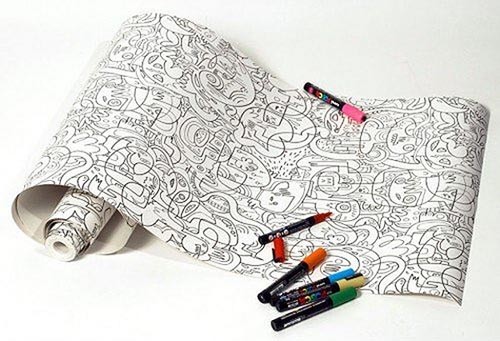
- Stone painting is a great option for those who do not have artistic abilities. Stencils can be downloaded from the Internet or made independently from any image. Also, stencils can be supplemented by the existing painting “by hand” (stars, butterflies, flowers, birds, etc.).
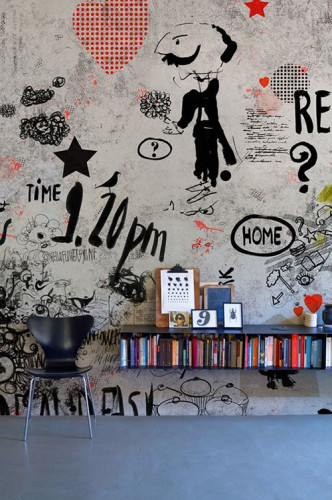
- Slaffel paint is an excellent invention that has become in the interior recently in the interior. Cover one wall (or only the lower part of the wall) with such a paint, and the child will have its own wall, on which you can draw finely with impunity and endlessly.
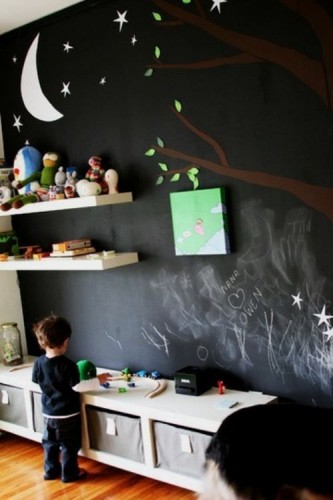
Useful advice: if you are going to hire an artist to paint the walls in the children's room, carefully read his portfolio and talk to the person personally. It is important that he not only knows how to draw well, but also understands the specifics of such work. It is important that a person is pleasant to you and your child, since the painting of the walls is a rather long lesson, and the artist will be in your house for several hours a day. And one more point-the master must truly love his job, because with the pattern applied, he leaves a piece of his energy, his daily mood. Therefore, try to create the most comfortable and pleasant working conditions for him.
What to draw?
It is necessary to choose a composition for painting walls, starting from the age, gender and character of the child, completely forgetting about personal preferences. Even if you make a room for a nor who has not yet been born or infants, believing that such a crumb is not yet able to adequately choose, you should not draw on the walls of Batman or Unicorn, if you are delighted with them.
There are certain rules that should be taken into account when painting a children's room with your own hands:
- For infants and children under 3 years old, a rather simple design of the room and interior as a whole is suitable. Pastel colors of several shades for walls and furniture are preferred. So that the interior does not turn out to be plain and boring, it is necessary to make several bright spots, but it is better to do this with the help of toys - in which case they can always be excluded from the composition. As for the drawings on the walls, it is better to make them the simplest: large objects, trees, clouds, birds, animals. The child must easily recognize the depicted subject, thereby studying and developing.
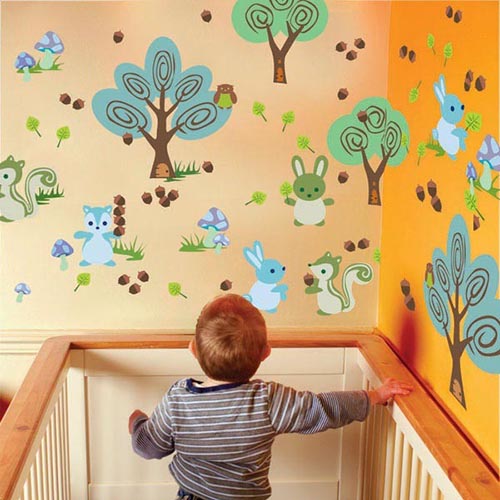
- For children from 3 to 10 years, more complex images can already be used in the design of the walls, since during this period of life the child is actively developing and comprehending the world around him. Now you can safely draw on the walls of the heroes of your favorite cartoons, scenes from fairy tales, etc. It is during this period of life that color preferences begin to form in children, therefore, before buying paints, consult with the future tenant of apartments. But even if the baby indicates bright and saturated shades, do not fill the whole room with them - this adversely affect the psyche. Use them carefully and only in the gaming area of \u200b\u200bthe room.
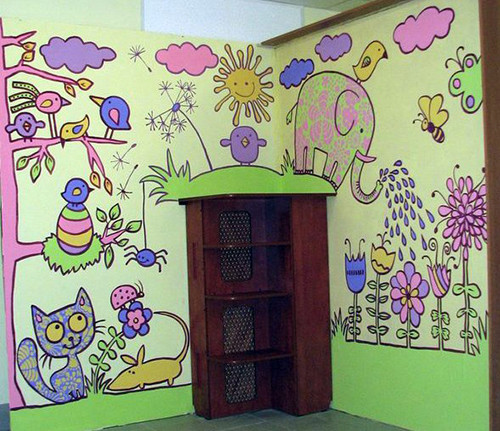
- From 11 to 16 years, the most difficult phase passes, both for children and parents. If you make a room for a teenager, you need to make a lot of efforts and in no case do not forget about the desires of the child himself. Of course, do not indulge all whims, but do not be afraid to compromise, allowing the child to choose a color scheme, for example. Get ready for the fact that he may not want to see bright and rich colors in the interior that he liked so recently. On the contrary, a small customer may be delighted with dark or “screaming” plain colors. In this case, you can use various abstractions in the interior: stripes, spirals, various geometric figures, randomly “scattered” along the walls, blots, etc. If the child has a craving for drawing, let him express himself, highlighting, for example, one wall or discussing and approving some sketch together.

Color scheme of the children's room
Most parents, developing the future interior design of the children's room, make the same mistake - try to turn it into the brightest and most multi -colored place in the whole world. The desire to delight the baby with juicy shades and hearing his baked laughter is quite understandable, but he is also a person, albeit very small. He also needs to sleep, concentrate, his eyes, which have just begun to work and see even at all, do not need a slurred kaleidoscope of multi-colored spots, capable of causing only irritation. Enter the colors and enhance their intensity is necessary gradually and accurately.
The impact of color on the psyche was known to an ancient scientist. This is a long -proven and undeniable fact, and the effect of color is the same, both for the baby and for an adult. The whole difference is only how sharply the subject perceives him.
Important: do not mix the symbolism of one or another color with the impact on the psyche. For example, in India, white is associated with the funeral and the transition to another world, while in most other countries of the world such events are “painted” in black.
It is always nice to look at light and white surfaces. White color helps a person relax, feel free and liberate. If the child is closed, the bright interior will help him overcome the stiffness. However, if white is in abundance, this will only aggravate the situation and create a feeling of unnatural sterility. In such a room, a person simply cannot relax.
Yellow color actively stimulates mental activity, promotes the development of intuition and helps to concentrate. He will look successfully in the interior of a room for a child from 7 to 16 years old. But even it should be in moderation. The child should not only develop and study, but also rest. There can be a working area yellow, and the recreation area can be painted in green, from which the eyes relax, and the mind calms down.
Do not get involved in red and orange shades, as they “excite the blood” - contribute to the hyperactivity of children. In such a room, the child will not be able to fully relax, will be capricious, pestering parents, they will also not be able to relax, and as a result the whole family will suffer because of such a seemingly insignificant factor, as an abundance of red in the interior of the nursery.
Blue color is considered the color of creative and extraordinary personalities, however, if there are many blue on the walls, this will entail not the disclosure of creative potential, but a nascent depression. With purple shades, you should also handle carefully, since they, depending on their saturation, acquire the properties of either red or blue. In moderate quantities, it is good in painting a children's room for a teenage girl.
When choosing a color scheme for a children's room, give preference to delicate pastel colors: blue, beige, creamy, pink, yellow and green. It is best to choose warm shades so that coziness and calm always reign in the room.
Ceiling in the children's room
Separately, I would like to talk about the design of the ceiling in the children's room. Many do not take it into account, emphasizing all attention on the walls, and as a result, the interior turns out to be incomplete.
The most popular motive for the design of the ceiling is the image of a heavenly arch. It can be a blue surface with light white clouds and birds flying in the leaf, or a night sky with stars and galaxies. If the child likes space, and he wants to see the night sky on the ceiling, be careful - the dark ceiling will “press”. For a room with a modest square, this is a death sentence, since it will seem very tiny.
Useful advice: Draw a neutral light sky with clouds so that the ceiling visually increases the space during the day, but when painting, use lighting paint. Draw it stars of dots, star clusters, galaxies and satellites. In the afternoon, this paint is not visible, and at night the ceiling will be transformed into a fantastic picture.
Do not forget that the design of the ceiling should overlap with the design of the walls and the interior of the room as a whole. If you are painting walls in a room for boys, voluminous figures and even toys can be attached to the ceiling - they will attract the attention of children, and they will quickly go to bed. However, such details must be periodically changed so that the interest of children does not weaken. If a starry sky is depicted on the ceiling, then you can hang a plane, satellite or rocket there. In the girl’s room, you can also use this technique, only instead of aircraft to hang birds, angels, fairies or flower buds.
Choosing paint for a children's room
So, if you have already decided how the child’s room will be decorated, you can go to the store for paint. However, there are so many all kinds of compositions on the shelves, and choosing one thing is very difficult. Here you will also help the realization of the fact that you are looking for paints for painting walls in the nursery, so they should be absolutely safe for health. It is also good that the painted surface can be washed, and it retains its original appearance for many years.
The painting for children should be carried out in safe colors, which include water -soluble acrylic and latex compositions. When buying, be sure to make sure a certificate of compliance with the ecology standards. Typically, these data are indicated on the label (hypoallergenicity, suitability for use in children's, environmentally friendly composition).
Important: in no case do not paint with alkyd -based paints, since they release toxic substances both during staining and after drying, and can provoke allergic reactions.
The safety of coloring materials is important at all stages, including the application period and after drying. Latex paints are more expensive than acrylic water-dispersion, but they are more resistant to wet cleaning, ultraviolet radiation, and minor mechanical damage. Moreover, the latex composition will hide small defects in the walls (cracks, chips, scratches), but if you want to achieve this, you should choose matte paint, not glossy (see the appropriate marking on the packaging).

